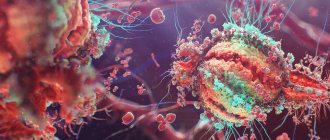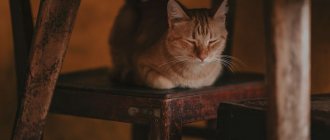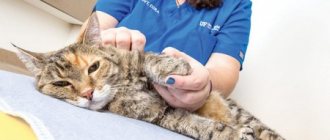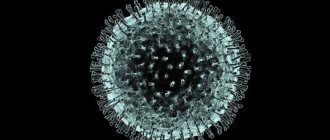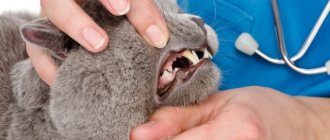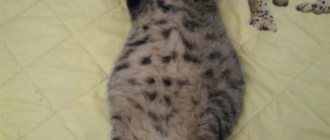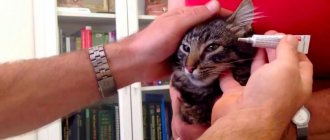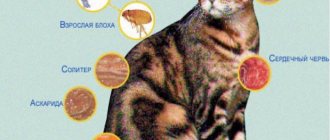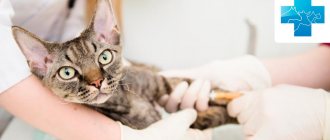Viral immunodeficiency in cats (infectious immunodeficiency virus, FIV, feline immunodeficiency virus, FIV) is a severe, predominantly latent (latent) deadly, incurable infection, which is characterized by serious damage to the entire immune system of animals.
The disease is also known as feline AIDS. It is essentially the feline equivalent of the human immunodeficiency virus (HIV), which causes the development of AIDS. The disease in cats progresses very slowly, but can complicate the course of other diseases and pathologies.
Symptoms and signs of infection increase gradually and may appear only after several years. In veterinary medicine, in most cases, the immunodeficiency virus is detected in middle-aged, older, and elderly cats that roam freely on the street.
The causative agent of the disease
Feline viral immunodeficiency is caused by a retrovirus belonging to the Retroviridae family, the Lentivirus group. The diameter of the pathogen does not exceed 100-116 nm.
Important! FIV was first isolated in 1987 from a cattery in North Carolina. In a large group of individuals the disease was chronic. Scientists gave the new, previously unknown virus the name T-lymphotropic lentivirus of cats (TLLV), but subsequently, according to the international classification, its name was changed to FIV - feline immunodeficiency virus.
The causative agent of this infection is not resistant to environmental conditions and, under unfavorable conditions, quickly loses its virulence.
- Temperatures of 55-60 degrees lead to its inactivation after 25-35 minutes.
- Higher temperatures and boiling destroy the virus almost instantly.
- At room temperature, FIV remains virulent for three to four days.
- The feline immunodeficiency virus is relatively resistant to ultraviolet radiation.
- Lentiviruses quickly lose their activity when exposed to various disinfectant solutions.
- Esters, alcohol, and aggressive chemical compounds kill dangerous pathogens almost instantly, within three to six minutes.
Antibodies to this virus have been detected in many representatives of the cat family living in zoos and in the natural environment around the world. At the same time, several strains of lentivirus have been isolated from wild cats. Antibody titers vary depending on age, conditions, and environment.
Recent data suggests that the prevalence of FIV in the UK is 13-15% among infected cats, with only 1-3% being latent carriers who do not show major signs of the disease. In America, lentivirus affects approximately 3-6% of animals. It has also been noted that males are more susceptible to feline AIDS.
When conducting diagnostic studies, FIV is detected in the saliva, bloodstream, and other physiological fluids of sick cats. After infection, the lentivirus remains in the body of infected animals for life, since immune antibodies cannot destroy it.
Structure
Genome structure of the feline AIDS virus based on available data 2013.
FIV has a similar structure to primate and ungulate lentiviruses. The virion has a diameter of 80 to 100 nanometers and is pleomorphic. The viral envelope also has surface projections that are small, 8 nm, and uniformly cover the surface.
The genome of the feline AIDS virus is diploid. It consists of two identical single-stranded RNAs, in each case about 9400 nucleotides, existing in a plus-strand orientation. It has the typical genomic structure of retroviruses, including gag, pol and env genes. The Gag polyprotein is cleaved into matrix (MA), capsid (CA) and nucleocapsid (NC) proteins. Cleavage between CA and NC releases a nine amino acid peptide, whereas cleavage at the C terminus of NC releases a 2 kDa fragment (p2). The Pol polyprotein is translated by ribosomal frameshifting, a feature of HIV. Cleavage of Pol by the viral protease results in the release of the protease itself (PR), reverse transcriptase (RT), deoxyuridine triphosphatase (dUTPase or DU), and integrase (IN). The Env polyprotein is composed of leader (L), surface (SU) and transmembrane (TM) glycoproteins. Like other lentiviruses, the FIV genome encodes additional short open reading frames (ORFs) encoding the Vif and Rev proteins. An additional short ORF called orfA (also known as orf2) precedes the env gene. The function of OrfA in viral replication is unclear, but the orfA-encoded product may display many of the attributes of HIV-1 accessory gene products such as Vpr, Vpu, or Nef.
The capsid protein, derived from the Gag polyprotein, assembles into the viral core (the protein shell of the virus), and the matrix protein, also derived from Gag, forms an envelope directly within the lipid bilayer. The Env polyprotein encodes a surface glycoprotein (SU) and a transmembrane glycoprotein (TM). Both SU and TM glycoproteins are highly glycosylated, which scientists believe may mask B cell epitopes of the Env glycoprotein, conferring virus resistance to virus-neutralizing antibodies.
How cats become infected with FIV
Considering that FIV is not resistant to external factors, cats are infected through bites and scratches, since the maximum concentration of lethivirus is contained in the saliva of infected individuals. When bitten, the skin and mucous membranes are damaged, the virus, penetrating the body of healthy cats, begins to multiply quickly.
The infection is transmitted through contact and sexual contact. Infection occurs through direct close contact or mating of healthy and infected animals.
The transplacental (intrauterine) method of infecting cats with the immunodeficiency virus was experimentally confirmed. The infection is also transmitted to newborn kittens through the milk, colostrum, and saliva of an infected mother cat . Congenital feline AIDS appears a few days after the babies are born.
FIV can be transmitted by blood-sucking insects and parasites . Ticks, fleas, and lice eaters can cause lentiviruses to enter the body of domestic cats, which leads to the development of a dangerous infection. Cases of animal infection following blood transfusion have been reported.
Who is susceptible to infection?
The feline immunodeficiency virus is widespread. Veterinary services register outbreaks of a deadly infection in all countries of the world. Both wild cats living in cities and rural areas, as well as pets that go outside for walks, can become infected.
According to statistics, stray cats and free-ranging animals are at greatest risk of contracting FIV. Considering that males more often get into fights with their relatives, protecting their territory, cats, unlike cats, are more susceptible to infection. It is also worth noting that animals of older age groups have more aggressive and antisocial behavior, so their risk of infection is higher than that of small kittens or young animals.
Important! A high percentage of cats being infected with feline immunodeficiency is noted in places where these animals gather in large numbers. That is, where cats, living in groups, are in close contact with each other.
If animals, for example, purebred domestic cats, have little contact with their relatives and go for walks under the supervision of their owners, the likelihood of horizontal infection is extremely low.
Severely weakened, emaciated individuals, cats suffering from various chronic, systemic pathologies, uncastrated males, females, pets with a weak immune system are susceptible to infection with the feline immunodeficiency virus.
The risk of contracting this infection increases in nurseries, shelters, and in places where cats are kept in groups with a dense population. If diagnostic measures are neglected and there is no control over the health of animals involved in breeding, the feline AIDS virus is quickly transmitted to other cats from latent carriers.
Other meanings
| « | The word “cat,” as scientists suggest, is borrowed from the Latin language, where cattus, catta are the names of domestic (not wild!) cats and cats. It is believed that the English cat, the German Katze, and the French chat are derived from this Latin word. This happened no later than the 4th century AD. e. - it was then that this word was recorded in Latin, and it was probably then that domestic cats appeared in Rome. The Old Russian word “cat”, derived from the word “cat”, obviously at first looked like *kotjьka. | » |
| — verbiage | ||
| « | xxx: Hello, what are you doing? uuu: Playing with my pussy... uuu: I mean with a cat!!! uuu: I know what you were thinking, asshole!!!! The user "uuu" removed you from his friends list! | » |
| — 412623 | ||
More pussies
| ◄ ► | The Dutchman made the corpse of his cat fly)»»> |
Kote. Spherical in a vacuum Kitten, hedgehog and mimimi Standing Cat is watching You! (spoiler:
The Dutchman made the corpse of his cat fly
) The key of awesome
reveals the topic of cat on the Internet Physical cat culture Cat music Fighting cat on a walk Antidepressant Even Karlin loved cat And Dugin calls for learning from cats
- On our Internet, devices (usually routers) from Cisco are also called cats or pussies.
- Cat/Campons - a piece of climbing equipment or a device for climbing poles.
- A cat is a small anchor for boats.
- A cat is a small board with a hole and hooks for putting it on an easel, if the painting reflects in the artist’s eyes, to change the angle of incidence of the rays.
- Pussy is a slang Americanized designation for the female genital pussy (lit. - pussy
), known in Russian thanks to illiterate translators and used by them as a stupid, dull euphemism. In one old American musical, girls offered to look at their pussies, after which they let kittens out of their skirt pockets. They say that this is where the word pussy came from in the sense of “jasper gate”, but it is not known exactly where the cause is and where the effect is. And in Slovakia this is also the president. - Glamorous pussy.
- The cat is a creature unknown to science (perhaps a substance?), used to pass through the shredder. Not to be confused with Schrödinger's cat!
- Kisa is an erroneous name for the bust of Semyon Mikhailovich Budyonny. If you tell the buyer of a kitty that he made a mistake and is not buying a kitty, but a bust of Semyon Mikhailovich, the buyer will go nuts and ask for two.
- Kisa - Vorobyaninov, accomplice of the great schemer.
- "Kisa" is an acetone triperoxide, an explosive initiator, widely known for its exceptional ease of preparation. In fact, very unstable and capable of snatching a finger or two off the pyrotechnics.
- "Kisa" ( kissa
) in racial Finnish SUDDENLY cat. - But “pussy” in Erzya means suddenly a dog!
- Kote is a cat on the verb.
- Kit is a cat in racial language.
How dangerous is FIV for cats?
The main danger of this infection is that several months or years pass from the moment of infection to the appearance of clinical symptoms. The viral infection has a hidden, latent course, which makes its early diagnosis difficult.
After penetration into the animal’s body, the lentivirus begins active reproduction in the body. The pathogen affects the cells of the immune system, leading to the death of lymphocytes, which negatively affects the general condition of our little brothers.
FIV is a deadly viral infection that will invariably lead to the death of the infected individual.
Therapeutic measures are symptomatic in nature and are aimed at relieving the symptoms of the underlying disease and increasing the immune potential of the infected animal.
Note that due to the polymorphism of clinical manifestations, diagnosis is difficult. Symptoms in FIV-infected animals are similar to those of other infections and diseases. To accurately confirm that a cat is infected with the immunodeficiency virus, a number of complex diagnostic measures and studies are carried out. The tests are expensive and not available in all veterinary clinics and laboratories.
Incubation period (or virus carrier stage)
If the immune system is strong enough, then the immune response, although it does not lead to the destruction of the virus, prevents its active reproduction. The disease may not manifest itself in any way. This stage can last for several years.
The animal becomes a carrier of the infection and can infect its fellow tribesmen. Within 2-5 years, under the influence of the virus, a significant suppression of the immune system occurs, which gives the pathogen the opportunity to become more active. During activation, a further decrease in immunity occurs.
[custom_ads_shortcode3]
Is FIV transmitted to humans and other animals?
Considering the similarity between FIV and the HIV virus, owners of furry purrs are interested in the following questions: “Is feline AIDS transmitted to humans?”, “Can you get infected from an infected cat?”, “Is FIV transmitted to dogs and other pets?”
Even if it so happens that your pet is diagnosed with a terrible illness, it has been scientifically proven that the feline AIDS virus is not dangerous to humans and is not transmitted to dogs or other pets.
The causative agent of this infection multiplies and is active only in the body of representatives of the cat family. Therefore, if it happens that your furry pet is diagnosed with a dangerous infection, it is impossible to infect humans or other pets with this disease.
But if there are several cats in the house and one of them is infected with lentivirus, it is possible that all of them will be latent virus carriers, since the animals are in close contact with each other.
Considering that kittens are adopted at two to three months of age, there is a slight risk. However, if cats do not walk on the street, you pay attention to your pets, promptly take the cat to the clinic for preventive diagnostics and tests, and you are confident that other animals are not carriers of FIV, the risk of spreading this disease is not so great.
Lentiviral vector
Like HIV-1, FIV has been developed into a viral vector for gene therapy.
Like other lentiviral vectors, acquired immunodeficiency syndrome virus vectors integrate into the host cell chromosome, where they can generate long-term, stable transgene expression.
In addition, the vectors can be used on dividing and non-dividing cells. FIV vectors could potentially be used to treat neurological disorders such as Parkinson's disease and are already being used to deliver RNAi, which may have applications as cancer gene therapy. ^Top
Symptoms and manifestations of immunodeficiency
The effects of the feline immunodeficiency virus on the cat's body are similar to those of the human immunodeficiency virus (HIV). Initially, after the penetration of a retrovirus, it primarily replicates in the cells of the lymphatic system, disrupting its functioning. The virus multiplies in the lymph nodes.
The action of the retrovirus is aimed at the cellular structures of the immune system. If an infection occurs, the immune system becomes vulnerable to viruses, bacteria, and protozoan parasites.
Against the background of FIV, sick animals often develop secondary infections and systemic diseases. If a cat is infected with FIV and a secondary viral or bacterial disease develops, the effectiveness of antibiotic therapy decreases and the treatment period increases.
Important! The immunodeficiency virus leads to a change in the percentage of CD4 and CD8 lymphocytes in the bloodstream compared to the physiological norm.
Signs of a viral infection are nonspecific. The intensity of their manifestation, the duration of the incubation period, which can last from three to four weeks to one and a half months, depends on the individual, physiological characteristics, age, conditions of the animal, activity and state of the immune system.
The acute stage of the disease gradually turns into a chronic form of the disease, which can last several months or years.
Symptoms and signs of the acute stage of FIV:
- unstable body temperature, hyperthermia;
- anemic mucous membranes;
- depressed state, decreased response to stimuli;
- weakness, drowsiness, apathy;
- loss of appetite, sudden weight loss, exhaustion;
- lymphadenopathy, enlargement, pain of lymph nodes;
- digestive disorders, prolonged diarrhea;
- deterioration of wool;
- lacrimation;
- inflammation of the ear canal;
- disruptions in the functioning of the genitourinary tract;
- difficulty breathing, irregular heartbeat;
- discharge from the nasal passages, eyes;
- allergic rashes, chronic dermatosis.
Important! In cats with immunological problems, autoimmune diseases, as well as in animals suffering from leukemia and other diseases, the symptoms of FIV are more pronounced and intense.
The first signs appear, as a rule, two to four weeks after the pathogen enters the body. Often the symptoms of FIV are similar to those of viral leukemia.
In the acute form of FIV in cats, the temperature rises sharply to 40-41 degrees, after which after a few days it returns to normal limits. Animals quickly get tired and become inactive. Very often, signs of infection are purulent, ulcerative gingivitis, stomatitis, periodontitis of varying degrees of complexity, conjunctivitis, uveitis, keratitis, and other systemic pathologies.
The most common signs of the initial form of FIV are diseases of the oral cavity, respiratory, and gastrointestinal tracts. There are obvious signs of fever and malaise on the face. Animals become apathetic and cease to be actively interested in the world around them. Cats seclude themselves in dark places, are reluctant to make contact with their owners, and refuse active games and favorite treats.
Risk factors
The immune system of a healthy cat limits the development of the virus, so the whisker looks healthy outwardly. When immunity weakens, the disease progresses. Factors contributing to the development of FIV in a cat will be:
— chronic diseases;
— low-quality feed and unbalanced diet;
— infectious diseases (especially herpes virus);
Read more: Treatment of herpes in cats
- stress;
- internal and external parasites.
Other manifestations of FIV in cats
In infected pets, in addition to a decrease in immune potential, symptoms of secondary, opportunistic infections (demodex, notoedrosis, chlamydia, calcivirus, pneumonia, bronchitis, candidiasis, cystitis, colds) are often noted.
Important! FIV carriers develop monocytosis, thrombocytopenia, acidosis, monocytosis, and acute anemia, which is confirmed by serological studies.
Very often, infected cats show signs of fungal infections and infectious dermatitis. The pet's code is affected by pathogenic fungi.
With this infection, the risk of developing squamous cell carcinoma, lymphosarcoma, and other oncological pathologies increases. It has been established that the feline immunodeficiency virus can provoke neuropathies, but this is not one of the main signs of this disease. In infected cats, the central nervous system is affected and encephalopathy is noted.
Diagnostics
To accurately diagnose VIC, a comprehensive diagnosis is performed. In addition to a general examination, clinical manifestations, and anamnesis data, the epizootological situation in the region regarding this infection is taken into account.
The diagnosis is made based on the results:
- ELISA (enzyme-linked immunosorbent assay). The method is based on thin layer chromatography. Shows the reaction of antigen and antibodies in biomaterials. Conducted using special test systems. The antigen is detected in the bloodstream of infected cats three to four to six weeks after infection.
- Serological studies (general, biochemical blood test). Signs of anemia, a decrease in lymphocytes, changes in the leukocyte formula, and hyperglobulinemia are noted.
- Differential diagnostics, CPR.
If necessary, other physiological fluids (urine, tear secretion, saliva, lymph) are subject to examination. Kittens that were born from an FIV-infected cat should be taken to the veterinary clinic for examination. Babies are tested up to three to five months and then regularly once a year.
Important! If there is a suspicion of FIV infection, in order to get the most detailed picture and not make a mistake in making a diagnosis, studies are carried out no earlier than two to three months from the moment of the suspected infection. Early diagnosis may show an inaccurate, false result due to the lack of production of antibodies to virions that have entered the body.
During postmortem examinations, muscle dystrophy, exhaustion, edema of the lungs and bronchi, and atrophy of some lymph nodes are noted.
What to do at home
Owners of immunocompromised cats should follow the veterinarian's instructions and provide quality living conditions for their sick pet. Great importance is attached to nutrition. The cat is prescribed a special therapeutic diet enriched with vitamins and minerals.
It is advisable to use hypoallergenic high-quality feed from well-known manufacturers. They contain nutrients in optimal proportions and are well absorbed by the animal’s body. You cannot skimp on cat food.
Every three months, your four-legged pet should be shown to a veterinarian who controls the disease. If necessary, he adjusts the treatment, increases or decreases the dosage of medications.
Treatment
Unfortunately, at the moment there is practically no treatment for FIV, and this infection is incurable. Therapy and therapeutic measures are primarily aimed at eliminating the main symptoms of secondary diseases and infections, strengthening the immune potential.
In the treatment of FIV-infected cats, specific immunoglobulins, anti-influenza, anti-measles serums, and antiviral drugs (zidovudine) are used. To normalize the animal’s condition, 0.5-1 ml of immunoglobulin is administered intramuscularly or subcutaneously every two to three days. Immunomodulators (interferon, acemannan) have a positive effect, but can cause side effects.
To suppress the activity of pathogenic flora, a course of antibiotic therapy and sulfonamides is prescribed. Broad-spectrum antibiotics or certain drugs that act on specific pathogens are used. The course of treatment is five to seven days. The medications, dosage, and frequency of administration are prescribed by the attending veterinarian.
In some cases, good results are observed after short-term use of corticosteroids, which relieve inflammation, but non-steroidal anti-inflammatory drugs are used extremely carefully when treating FIV-infected cats.
To strengthen the immune system, animals are required to be prescribed multivitamin, vitamin-mineral complexes, and homeopathic preparations. Antihistamines (tavegil, suprastin) are prescribed.
Caring for FIV animals
The prognosis for diagnosing FIV is disappointing and cautious. The infection is incurable, but even if the diagnosis is positive, this is not a reason for euthanasia. Some FIV cats live quite a long time and die of old age. Viral immunodeficiency is not always the main cause of death. Infection only aggravates associated secondary diseases. The life expectancy of cats with FIV depends on age, physiological, individual indicators, conditions of detention and care.
Owners of infected animals should understand that their furry pet needs increased attention and care. Do not forget that a cat is a lifelong carrier of the virus, so it is worth protecting your pet’s communication not only with stray animals, but also with other cats.
At home, it is very important to create optimal living conditions for your cat. Protect your cat from stress, potential carriers of infection. Avoid hypothermia or overheating of your pet. Regulate your level of physical activity.
Strengthen your cat's immunity with special complex supplements and vitamin preparations. Carry out deworming and treatment of the coat against ectoparasites in a timely manner. As for vaccination, infected cats need to be vaccinated extremely rarely and only as indicated by a veterinarian. Inactivated sera and killed vaccines are used. Clinically sick animals are not vaccinated!
If you follow the doctor's recommendations, a pet infected with the immunodeficiency virus can live a happy life for several more years.
Prevention
At the moment, FIV is a poorly studied infection, so a preventive vaccine against this infection has not been developed in our country or abroad. It is very important to prevent your pet from contracting a dangerous infection. Monitor the cat’s condition and behavior, strengthen the immune system, and consider the correct diet. If the cat is kept on a natural diet, give fortified food supplements and complex vitamins to strengthen the immune system.
If a cat is walking on the street, we recommend spaying or sterilizing the animal. This will avoid uncontrolled mating and fights between individuals of the same sex. Uncoated males behave more aggressively and are intolerant of their relatives.
Do not neglect vaccinations and deworming. Systematically treat your pet with products against external parasites, regardless of whether the cat walks outside or does not leave the house. If you notice signs of illness, do not delay your visit to the veterinary clinic. Many diseases can be cured only in the early stages of development.
